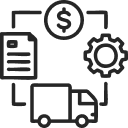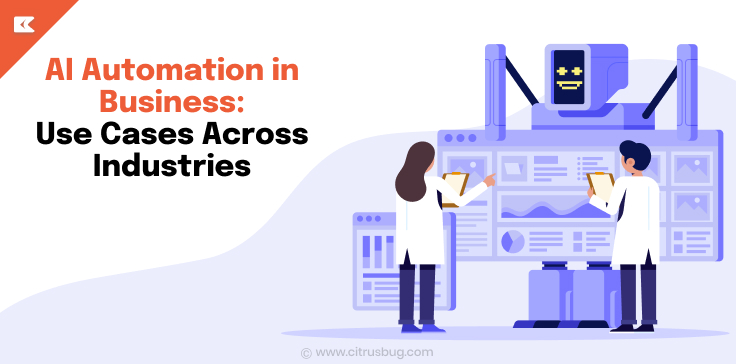10 Real-Life Best Digital Transformation Examples
- August 22, 2024
-
2978 Views
- by Ishan Vyas
Introduction
Digital transformation is ultimately using technology to transform how a company functions and ultimately serves its customers. It is not merely about purchasing new devices or software. Instead, it involves reimagining whole processes, using data to make decisions, engaging consumers, etc. This also consists of the use of cloud computing, artificial intelligence, and mobile technologies. Why is this important?
The aim is to make the entire organization more effective and future-ready. According to Statista, worldwide digital transformation expenditures will reach $3.4 trillion by 2026. Many companies have undergone a digital transformation and turned this challenge into an opportunity. It is essential to select the right area for digital transformation. Let’s try to understand what digital transformation is and how it can change your business in detail. We will also provide 10 real life digital transformation examples. So that you can build your digital transformation strategy to achieve your business goals.
What is a Simple Example of Digitization?
Let us use an example to understand digitization better. An example of business digitization is the shift from using paper invoices to digital ones. Usually, paper invoices are manually filled out by a staff member once a product or service has been delivered. People used to receive paper invoices by mail or hand for future reference. But the process has changed. Businesses use software like QuickBooks and Excel to generate soft copies (in PDF format) of these documents. The digital invoices can be emailed to customers or made accessible online. They are kept on cloud storage systems or digital databases where they can be easily found using keywords or software filters.To ensure easier sharing and storage, businesses can also reduce the size of digital invoices using tools such as Compress PDF tool, making them more manageable without compromising quality.
10 Real-Life Best Digital Transformation Examples
1. HSBC (Bank): Transition to Cloud Computing
HSBC brought a significant digital transformation in the banking sector. HSBC’s digital journey focused on the adoption of cloud computing. It enabled a hybrid work model after COVID-19. Consequently, this shift in strategy allowed the bank to reduce its physical space at its headquarters by 25%.
Additionally, shifting to these systems located in the cloud enhanced operational flexibility, permitting employees to work remotely while still being productive. Further, it increased HSBC’s ability to scale up its digital services, improve data security, and streamline IT infrastructure. This move demonstrates how banks can use technology as a way of adapting to new working conditions.
2. Ikea: Transforms Its In-Store Experience
Ikea is a well-known furniture store worldwide. They introduced sophisticated supply chain and inventory control algorithms. This methodology utilizes technology to best stock levels, minimize wastage, and increase product availability.
Ikea also launched in-store augmented reality apps that enable customers to see how furniture would appear in their houses. Furthermore, the company introduced mobile checkout kiosks with digital interfaces to reduce queues. The digital transformation strategy resulted in better customer experience and improved business operations.
The idea brought offline and online shopping closer together. This exemplifies how traditional stores can use technology for more effective, enjoyable, and individualized purchasing occasions.
3. UPS: On-Road Integrated Optimization
To stay in a logistics company, you must prevent human error and speed up delivery. The digital transformation at UPS was fixated on its inventive On-Road Integrated Optimization and Navigation (ORION) system. It is an AI-enabled tool, which considers parameters such as traffic, weather, and package priorities to come up with the best delivery routes. UPS saves millions of dollars on fuel and significantly lowers carbon dioxide emissions through ORION.
Also, they introduced advanced ways of tracking packages and providing real-time information about deliveries to clients. Furthermore, this shift at UPS has also included automated warehouses and a new delivery method using drones for some items only.
As a result of this comprehensive digital changeover, efficiency has increased, costs have been brought down, and customer service has been improved, thereby positioning UPS as a trendsetter in digital transformation within the logistics industry.
4. National Health Service (NHS): Started Remote Monitoring
The National Health Service (NHS) is the UK’s publicly funded healthcare system. They brought effective digital transformation in healthcare. The NHS’ IT revolution was designed to manage a predicted decline in physicians through remote patient examinations. This scheme uses electronic wearable appliances with software that reads patients’ body indicators at home. The system can identify health problems earlier, thus reducing hospitalization.
The NHS has established the industry standard for remote monitoring of chronic conditions. Over 487,000 patients were supported at home by the NHS between November 2020 and January 2023.
5. Nike: Digital Transformation to Offer Personalized Customer Service
Nike’s digital transformation focuses on creating a personalized and smooth customer experience across all channels. In this process, they developed an app called Nike+ that suggests the best products to customers depending on their preferences and how much they exercise.
Similarly, Nike launched another innovative online platform, NikeID, allowing clients to design their shoes while still at home.
In addition, the company introduced mobile checkout in its stores as well as personalized shopping experiences based on consumer information. Besides, using data analytics in supply chain analysis has also enabled suppliers to optimize inventory levels. It has enabled direct-to-customer sales improvement by increasing clients’ loyalty.
6. Amazon: Digital Transformation from an Online Bookstore
As we all know, Amazon is a multi-billion dollar company. The online bookstore turned into a global e-commerce and technology giant. Their digital transformation team invented AI-driven personalized recommendations and used advanced robotics for logistics in its warehouses. Besides, the company developed AWS, which is now a leading cloud computing platform. In e-commerce, Amazon’s innovative features like one-click purchasing, Prime membership, and Alexa voice assistant have become the new norm.
Their strategies are data-driven and pay attention to what their customers want. Thus, they have disrupted several industries, including retail, entertainment, and cloud services. As a result of static digitalization, the company is where it is today. For businesses looking to understand Amazon’s internal structure or reach out to decision-makers, tools offering access to an Amazon employee database with email and job titles can provide valuable insights into its corporate network.
7. Starbucks: Using AI Tech for Customer Satisfaction
Starbucks uses AI and big data to enhance customer satisfaction. They use predictive analytics in their Mobile Order & Pay app to suggest personalized orders and optimize wait times. In-store, AI-powered machines ensure consistent quality in beverage preparation. Starbucks’ loyalty program uses data analytics to offer tailored rewards and promotions.
They also use AI for inventory management and store location planning. This data-driven approach has improved operational efficiency, reduced waste, and created a more personalized customer experience. Starbucks’ transformation shows how AI can enhance customer service and business operations in the food and beverage industry.
8. AUDI: Introducing Digital Showroom
Audi’s digital showroom represents an evolution of the car retailing industry. These showrooms have large touchscreens and virtual reality to display the entire range on a relatively small footprint. Potential customers can select different specifications and features for their desired vehicle.
Instead of building extensive, expensive showrooms, this helps to make them more interactive and personalized. Audi also integrates online and offline experiences. It allows customers to transition seamlessly between digital exploration and physical test drives.
9. Netflix: Transformative Digital Journey
Netflix’s digital transformation journey reshaped the entertainment industry. Netflix started its journey as a DVD rental service. They focused on web application development and started a streaming service in 2007. Now, the company has more than 269.6 million users. They further transformed by creating original content based on viewer data. Their cloud-based infrastructure ensures seamless global service delivery.
Netflix’s transformation showcases how digital technologies can disrupt traditional business models and create new revenue streams. The company delivers personalized entertainment and media experiences at scale, setting new standards.
10. Walmart: Using Machine Learning to Offer Personalized Deals
Walmart has digitally transformed itself through the implementation of machine learning principles. It helps to enhance customer experience while boosting operational efficiency. They also apply artificial intelligence (AI) to personalize online shopping experiences. They offer specific product suggestions and deals depending on consumer behavior trends and tastes.
Walmart has had robot assistants installed in some stores that attend to inventory control purposes plus have mobile checkout programs introduced too within these shops. Further, the company extends its improvement measures to the supply chain by using predictive analytics tools for demand forecasting and stock management.These analytics not only support inventory management but also contribute to more effective advertising strategies through Walmart’s advertising agency.
Walmart has developed its omnichannel strategies to remain relevant in an era where people shop online.
Brands That Failed to Keep Up with Digital Transformation
Many renowned companies have failed to adapt to digital transformation. They struggled and lost a significant amount of money. Brands fail to keep up with digital transformation due to resistance to change, lack of vision, and inadequate investment in technology. They often cling to outdated business models, ignore emerging trends, and struggle with integrating new systems. This leads to missed opportunities and an inability to compete in the evolving market. Here is a short list of companies that failed to cope with the digital transformation journey.
-
Blackberry’s Struggle with Platform Evolution
Blackberry was a leader in the smartphone space. They tried to switch to BlackBerry 10 OS. It was not all smooth sailing, though. However, it took a long time before Blackberry introduced its new system. They missed out on some critical apps and developer support. The market response turned out to be wrong. Internally, Blackberry would not budge. They did not make the advantages of the new platform clear to these people.
-
Kodak’s Digital Transformation Delay
Kodak invented the first digital camera. However, they took a long time to embrace digital photography. They wanted to protect their film business. This made them reluctant to innovate.
Competitors quickly adopted digital tech. Kodak’s market share dropped sharply. They failed to disrupt their business model. This shows the danger of clinging to old products. Kodak’s fall is a warning to companies that resist needed changes.
-
Ford’s Attempt to Transform into a Mobility Company
Ford announced big plans in 2016 to become a mobility services provider. They focused on self-driving cars and ride-sharing. But their strategy was too early and poorly executed. Ford didn’t understand the market well enough.
They faced significant operational and cultural challenges. Their digital goals didn’t match their core skills. They struggled with market realities. This shows the need for a solid business model. It also highlights the importance of overcoming internal resistance.
Levels of Digital Transformation
-
Incorporating Digitization into Business
This is the most basic level, where you change information that was analog into digital forms, such as scanning documents to create electronic records.To enhance this process, you can utilize a PDF editor to modify and manipulate the digital documents conveniently.
-
Bring Change in Traditional Process
This is where organizations start incorporating digital tools and technologies within their existing processes. It could involve using e-mail communication systems or essential task management software. In addition, integrating these tools facilitates efficient client project management by streamlining communication and improving task coordination.
-
Digital Technology Optimization
In this stage, firms now use digital technologies to improve their existing business processes. They implement customer relationship management (CRM) systems and use data analytics to make decisions.
-
Business Transformation
This refers to the point whereby businesses will transform their models of operation. They create new value propositions based on digital technologies. This may include developing new digital products or services versus rethinking entire customer experiences.
-
Using Digital Technology to Make Decisions
At this stage, digital technology is fully integrated into all facets of the organization. The organization is agile, data-driven, and constantly innovating.
-
Industry Transformation
This is the highest level where digital changes extend beyond an individual organization’s activities to trigger a reshaping of whole industries. For example, E-commerce has affected retail trade, and streaming services have revolutionized entertainment.
Nevertheless, these levels aren’t always strictly linear, and it might not be unusual for different parts of an organization to be at other places on this scale.
Final Words
I hope you now have a detailed idea about digital transformation. It involves using technology to fundamentally reshape a company’s operations and customer interactions. Companies like HSBC, Ikea, and Amazon show how adopting new technologies can boost efficiency, improve customer service, and give a competitive edge. On the other hand, companies like Kodak and Blackberry demonstrate the risks of not keeping up with technology.
Businesses should invest in an expert digital product development company to achieve the best possible results. You need a reliable digital transformation team like Citrusbug to make the right decisions for your business.





 SaaS Development
SaaS Development Web Application Development
Web Application Development Mobile Application Development
Mobile Application Development Custom Software Development
Custom Software Development Cloud Development
Cloud Development DevOps Development
DevOps Development MVP Development
MVP Development Digital Product Development
Digital Product Development Hire Python Developers
Hire Python Developers Hire Django Developers
Hire Django Developers Hire ReactJS Developers
Hire ReactJS Developers Hire AngularJS Developers
Hire AngularJS Developers Hire VueJS Developers
Hire VueJS Developers Hire Full Stack Developers
Hire Full Stack Developers Hire Back End Developers
Hire Back End Developers Hire Front End Developers
Hire Front End Developers AI Healthcare Software Development & Consulting
AI Healthcare Software Development & Consulting Healthcare App Development
Healthcare App Development EHR Software Development
EHR Software Development Healthcare AI Chatbot Development
Healthcare AI Chatbot Development Telemedicine App Development Company
Telemedicine App Development Company Medical Billing Software Development
Medical Billing Software Development Fitness App Development
Fitness App Development RPM Software Development
RPM Software Development Medical Device Software Development
Medical Device Software Development Patient Engagement Software Solutions
Patient Engagement Software Solutions Healthcare IT Consulting
Healthcare IT Consulting Mental Health App Development
Mental Health App Development Lending Software Development Services
Lending Software Development Services Payment Gateway Software Development
Payment Gateway Software Development Accounting Software Development
Accounting Software Development Mobile Banking Software Development
Mobile Banking Software Development Supply Chain Management Software Development
Supply Chain Management Software Development Fleet Management Software Development
Fleet Management Software Development Warehouse Management Software Development
Warehouse Management Software Development LMS Development
LMS Development Education App Development
Education App Development Inventory Management Software Development
Inventory Management Software Development Property Management Software Development
Property Management Software Development Real Estate CRM Software Development
Real Estate CRM Software Development Real Estate Document Management Software
Real Estate Document Management Software Construction App Development
Construction App Development Construction ERP Software Development
Construction ERP Software Development

















